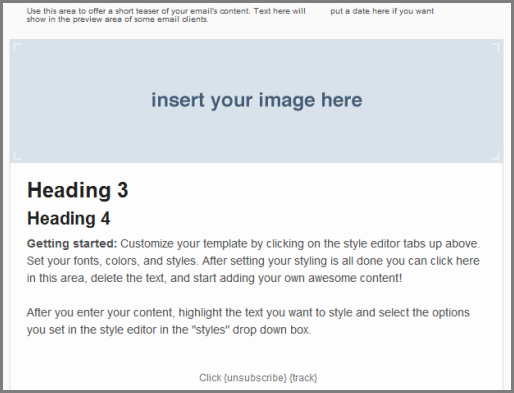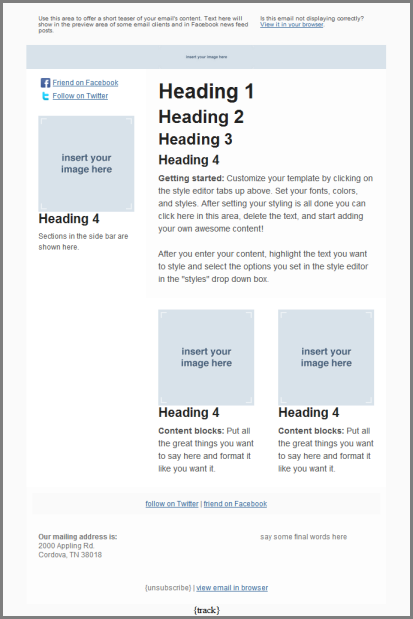Email Templates¶
What Are Templates?¶
- Templates¶
Templates are a means for a church to brand its emails by including items such as your church’s name, address, phone number, website URL, and a logo. We encourage you to always include the {unsubscribe} link in the templates themselves, so each emailer does not have to remember to include it. You may also want to include the {track} and {tracklinks} codes directly in the templates.
See also
Each ministry or special event can have it own template, especially if each has its own logo.
Email templates can be created or modified only by the system Admin or a user with the EmailTemplates role. While templates can be created only by certain users, the purpose is for every user that sends emails to have access to the templates he needs.
Suggestion
Instead of modifying these templates, clone the template to create a new copy and modify the copy. See the section below on Copying Templates.
Warning
Emails and email templates can easily become too large to send if you copy content from Microsoft Word into your email, since your email can become bloated with hidden code.
Copying Templates¶
To copy a template, open the template (by clicking on its name). Below the body of the template, click on the Clone button, change the template name if desired (by default it will be named with the orginal template name followed by ” Copy”) and save the new copy by clicking the Save Template button.
Starter Templates¶
These are the templates that are included in every database. Some are based on our HTML email builder and one is created in our Mobile Responsive email builder:
See also
- Empty Template (HTML)
This does not contain any content except an {unsubscribe} link. You may choose to modify a copy of this one by inserting a footer with your church’s basic information. That will insure that every email that is sent by your users contains that information.
- Basic Template (HTML)
Below is the basic template. This containes a header, placeholder for an image, content block, {track} replacement code and the {unsubscribe} replacement code. Remember that the track code only works when there is an image.
The default Role is Everyone. Obviously, for your church’s basic template, you certainly want everyone to be able to use it.

- Basic Newsletter Template (HTML)
This is designed for you to use for your church’s newsletters. This one is formatted like a newsletter, with columns and placeholders for images. You can insert your logo and save the template for use with all of the newsletters that are sent for your church through TouchPoint. Or, you may want to save several newsletter templates - one for each ministry. The template contains a footer to include the church information, the {track} replacement code, the {unsubscribe} replacement code, and a link to view the email in a browser.
Here is the starter newsletter template.

- Example Template (mobile responsive)
This is designed as a basic call to action template. It contains a placeholder for a header image, content block, button, social media links, church information and a way to opt out of the involvement that is triggering the email.

Email Templates and Roles¶
The default role for email templates is Everyone and they are available to all users except My Data Users. However templates can be assigned different roles, which you may want to do to restrict certain templates to a specific ministry or staff member(s).
- Existing Roles
You can use existing user roles and assign those to certain templates. For example, you want only those with Finance role to use the template you create that has a footer with links to your online giving page, so you assign the role Finance to that template. Or you may create a template for Membership, for those staff members working in that ministry to use. You can also have templates that are open to most of your staff, but not lay leaders. So you could limit the template to those with Edit role.
- Create New Roles
You can create roles to use just for locking down templates if you need to restrict the template more by the ministry rather than the standard user roles.
Be sure to create the role, assign it to those who need it, and then select that role for the template.
See also
Use Case
You create a template for your Student Ministry containing their logo, links to their website, and the ministry’s phone number. In order for this template to display for only those in Student Ministry, create a role named Student Ministry and assign that role to only those users in your Student Ministry who you need to be able to send emails using that special template. Then assign that role to the template.
Identifying Templates¶
Emails built with the Mobile Responsive builder will have this symbol next to the template or draft name:

If that symbol isn’t present, the email was created by the HTML builder.
Note
When using Creating New Draft from the Email Details screen, an email originally created by the Mobile Responsive builder will open with and can be edited ONLY by the HTML builder.
Latest Update |
06/13/2025 |
Removed template creation content and created two new articles
